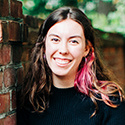
Nora Bost
Nora Bost is a junior marketing major and advertising and public relations minor in the Honors College and is from Fort Mill, South Carolina. She is passionate about photography, ultimate frisbee and houseplants.
Posted November 19, 2020
By Nora Bost
As newspapers look for ways to cut costs, laying off staff photojournalists is often the first step. Stock photos, wire photos and amateur photos often take the place of professional staff photos.
“We’re such a visual culture,” says associate professor Tara Mortensen. “Many audiences, including myself, don't do a lot of reading. We’re looking at the picture, the headline, and the caption. That’s our news.”
What happens when the quality of that visual news is compromised? That’s exactly what Mortensen is trying to figure out.
“It is my hope that when we get this information and we find out the truth about the value of photojournalism, that that will have an effect on the quality of visual news,” Mortensen says.
Mortensen is originally from South Dakota. She has a Ph.D. in journalism but has always been captivated by photojournalism and visual communications.
“It’s just so much more fascinating than words alone,” she says.
In addition to her research, she teaches several classes in the School of Journalism and Mass Communications.
In her most recent study, Mortensen and her colleagues sought to compare perceptions of credibility of a journalistic photograph and a stock photograph. Participants were shown pictures of what we might typically see in the news: a student graduating from high school, a father coming home from deployment and a car accident. In order to gauge perceived credibility, participants were asked a series of questions about the different constructs that make up credibility, including whether or not the images seemed accurate, current and trustworthy.
For example, to gauge perceived photojournalism professionalism, participants would rate their agreement with statements such as “This photographer captured what the person in the photo was genuinely feeling” or “The photographer likely told the person in the photo how to pose.”
The scores for all questions were calculated for each group of photos — photojournalistic and stock.
“Credibility is all about truth and perceptions of truth,” she says. “Can people tell that a stock photo is a big load of baloney?”
Her study showed that participants really could tell a difference. Credibility perceptions for staff photos were significantly higher than credibility perceptions for stock photos, indicating that stock photos in the news were perceived as less trustworthy, less accurate and less professional.
But Mortensen doesn’t want to stop here – her next research project will involve measuring participants’ unconscious emotional reactions to journalistic photos and stock photos. The setup will be similar to her previous study but will take place in the College of Information and Communications’ Biometrics and User Experience Lab. Participants will view a set of images either taken by a professional photojournalist or pulled from a stock photo source. But instead of self-reporting their responses to each photo, specialized eye-tracking, skin conductance and facial recognition equipment will be used to measure minuscule changes in emotion. Current literature suggests that journalistic photos are more emotional and should evoke more emotions from their viewers. Due to COVID-19, she has not yet been able to start this project, but she can’t wait to begin.
“I haven’t been in the lab for so long,” she says. “I miss it.”
Overall, Mortensen wants to discover the truth about the value of high-quality photojournalism. Her research thus far has proven that “professional photojournalists are not disposable.” She believes that audiences understand and appreciate the difference between journalistic and non-journalistic photos.
“The implications for crummy, false, uncredible photographs telling us about the world are huge,” Mortensen says. “That bothers me. I guess that’s the big picture of why I do the research that I do.”
I chose to interview Dr. Mortensen because I could tell from reading her profile that we share similar interests. As an amateur photographer myself, I was intrigued by her work examining the effects of the de-professionalization of photojournalism. After reading one of her published papers, I knew she was the faculty member I wanted to interview.
Dr. Mortensen, although not a photographer herself, is incredibly passionate about visual communications and photojournalism. She is pained by the layoffs of staff photojournalists and strives to show that “not any picture will do.” High-quality journalistic photos have clear, observable value to the public. While she made it clear to me that researchers “aren’t out to prove anything — the results we get are what they are,” it is evident that she hopes her research will lead to a better understanding of the emotional and perceived differences among different types of photography. I admire Dr. Mortensen’s passion and hope that I will find a similar joy in my future career as well.
In addition to learning about Dr. Mortensen’s current area of research, I think I also got a few ideas about an area to research for my senior thesis. We are currently working out a schedule for me to come to the Biometrics and User Experience Lab to help out with her upcoming research project. Overall, I was fascinated by Dr. Mortensen’s work and am excited by the opportunity I have to work with her either this semester or in the spring.

Nora Bost is a junior marketing major and advertising and public relations minor in the Honors College and is from Fort Mill, South Carolina. She is passionate about photography, ultimate frisbee and houseplants.